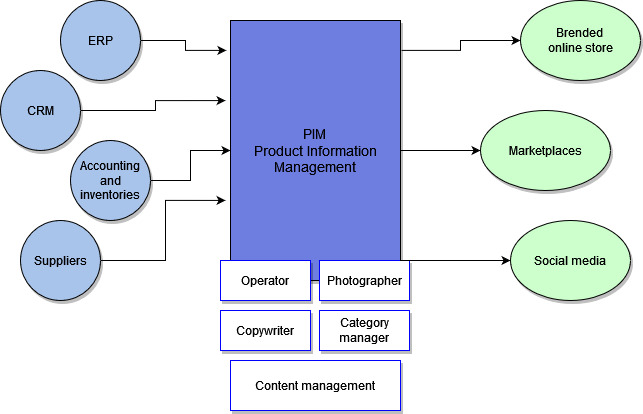PIM-System – Who Needs it and Why
What is a PIM system? The abbreviation PIM stands for Product Information Management. PIM systems are widely used in e-commerce, and for brands with many products in various D2C channels, they are simply necessary.
At first glance, the task does not seem complicated – you need to save the picture, description, and price. But let’s take a closer look at what kind of information is stored, what path the info goes through, how it is stored and processed.
Initially, information about the goods is stored in the accounting programs of the manufacturer or seller, accounting, warehouse, or ERP-complexes. As a rule, it contains data on the name and price. Sometimes some technical characteristics and a picture of the product are added. Is this enough for a PIM system? As a rule, no, because all information will be transferred to the product cards. Each marketplace has its own card layout, which contains many other fields.
The name and description should be understandable to buyers and contain keywords, and the photos should be taken by a professional photographer for the online store. In addition, other data is needed.
- Product category in the general catalog.
- Technical characteristics – power, kettle volume, cable length, type of stand, etc. Such characteristics can be extensive.
- Different variations of the same product. For example, different colors of the same kettle model or different clothing sizes. It would be incorrect and impractical to present this data neither as a separate product nor as a technical characteristic of the same product. It won’t be an optimal solution for product cards display.
- Media content: high-quality photos, videos, 3D images.
- Marketing data: keywords, information about included, related, or similar products.
- Logistic information: weight with and without packaging, type of packaging, shelf life, or special storage conditions.
- Other data – certificates, translations into other languages if selling in other countries.
All this information is entered into the PIM and verified. After that, it is ready to use.

Then the data about goods is exported into the cards of the online brand store for the marketplace. They all have different display formats, and each marketplace has its own requirements and nuances. The PIM system must connect to the brand’s D2C channels; why would you use it otherwise?
As a result, instead of entering each product into the online brand store, whether on Amazon, eBay, Mercado Libre, or anywhere else separately, the brand exports and updates the information using a PIM system. Obviously, it significantly simplifies the processing of products information for different D2C channels and reduces the likelihood of mistakes. If you need to change certain product information, you only need to update it once in PIM.
To summarize: PIM-system is a program for structured storage of a large amount of information about goods and its management. Introducing a PIM system reduces processing time and efforts to manage product information and possible errors in this process. But there are quite a few PIM systems on the market. Let’s see what you can choose from.
There are free PIM systems that are more suitable for small businesses. They have limited functionality in terms of introducing product characteristics and automation scenarios (there are practically none), and most importantly, the possibilities of import and export are significantly reduced. Also, the implementation and use of such a free solution require the involvement of a programmer since free PIM systems usually don’t provide user support.
When choosing a PIM system, the brand always faces a dilemma. On the one hand, existing package solutions are often adapted to one or more of the most popular marketplaces and have strict requirements for the imported and exported data format. This makes integrating with existing accounting systems and online sales channels difficult. There are also entirely flexible solutions, but they require long-term work of the IT department to connect and integrate, which can be expensive.
PIM Solution offered by Syntes is unique – it is a block builder that can be adapted to existing online sales channels and deploys quickly and efficiently, without requiring many months of work of programmers. Data can be imported in various formats via Excel, csv, and xml files and via the API protocol. This allows flexibility in choosing the initial database when integrating a PIM system. For example, you can download product information from an accounting program, CRM, Amazon, eBay, or simply from Excel files.
In addition, Syntes PIM is part of the overall Syntes MDM platform, and product information can be used effortlessly in other applications – manage orders, customers, stock balances, marketing activities. Product data in all D2C channels is synchronized automatically or semi-automatically, and analytical reports are available in graphical form and as a table.
Syntes PIM supports work with various marketplaces. In fact, the list of these marketplaces is open; different use cases are possible for other product models. If your brand already has an online store and storefront on Amazon, starting on Mercado Libre or Ozon using our platform can be done much faster and easier.
You can request a consultation on implementing a PIM system for your company or a demonstration of Syntes PIM by filling out a simple form here. Our representative will contact you by mail to schedule a consultation upon its receipt.
[elementor-template id=”9023″]
© Copyright Syntes, Inc. Copying, reprinting, and any reproduction is permitted only with the written permission from Syntes, Inc.






